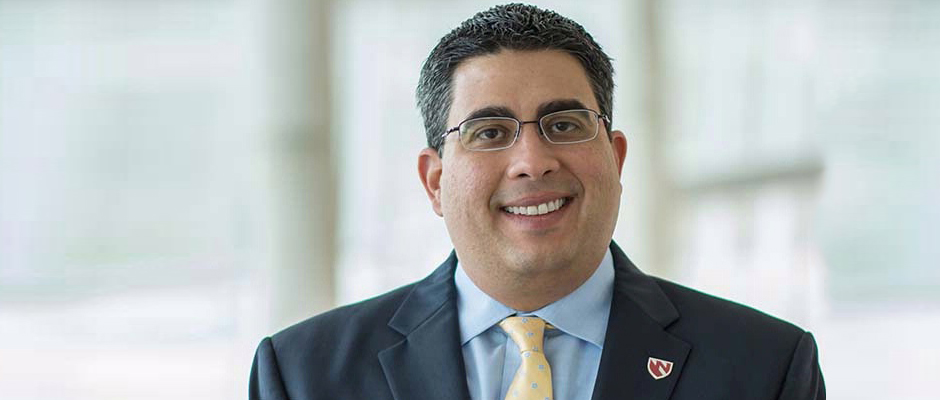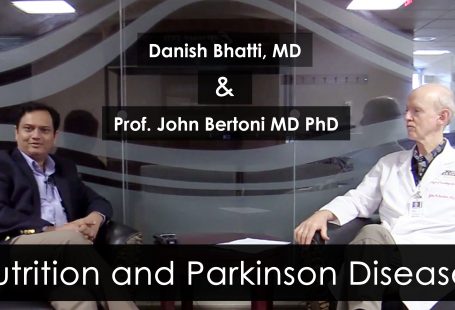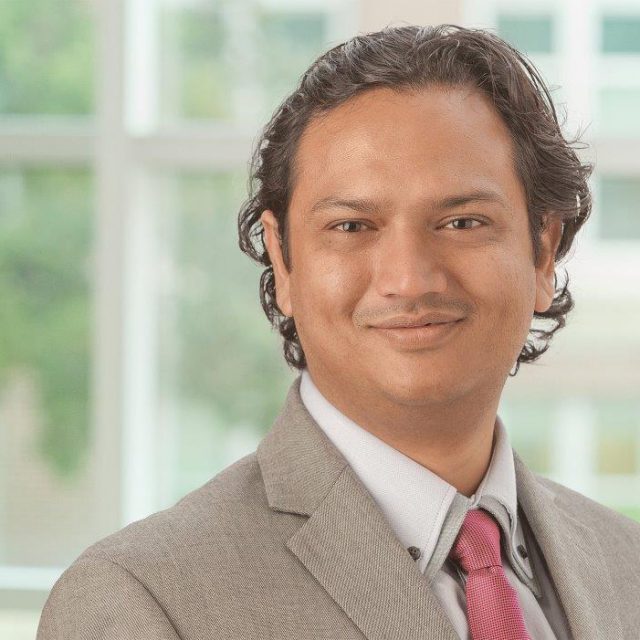
Danish Bhatti: Hello and welcome to the MD podcast. I’m Danish Bhatti. This week’s podcast will focus on Tremor disorders and to talk about it today on our show we have Dr. Diego Torres-Russotto, the director of Movement Disorders Program and movement disorder fellowship at the University of Nebraska Medical Center (UNMC). We’ll talk to him about his inspiration and interest in tremors, how he got interested in orthostatic tremors a very obscure and rare disorder. We’ll also get to know briefly his work with the Tremor interest groups and committees in AAN (american academy of neurology) on developing guidelines and physician tools. We’ll ask him about his most interesting patient with tremors. His Oliver Sacks moment.
Danish Bhatti: So Diego why don’t you start with telling us a little bit about yourself. Tell us one thing that you think no one will know about your career and movement disorders.
Diego Torres-Russotto: Well thank you Danish for having me. I’m very excited to be here and participating in these amazing podcasts. The one thing that many people might not know is that I was exposed to the patients with Huntington’s Disease in Venezuela where I was born and when I trained as a physician. And I went to, you know, those small towns where Huntington’s disease prevalence was so high and so all of those patients having very significant Chorea. It was really astonishing to see that half of the town had Huntington’s disease.
Danish Bhatti: Now I understand that knowing you, working with you, that part of your training involved working in the very remote areas of your country. Can you tell us something about that.
Diego Torres-Russotto: Yes so in Venezuela medical school takes seven years and after that to be able to be licensed as a physician you have to work in a rural environment for a year. And if you don’t do that then you don’t get licensed. So me and my wife got assigned to this jungle area in Venezuela, is that cocoa producing area. And we had all sorts of interesting stories. We had snakes coming out of our house. We had monkeys that live you know in the town with us we had. My wife was in charge of 5000 people town and she was the only physician there and I had to travel a little bit among smaller towns to be able to care for the people.
Danish Bhatti: Wow that’s fascinating. So getting back to today’s topic a little bit. What do you find most interesting about tremor disorders.
Diego Torres-Russotto: So I think that the first thing that calls my attention is how common they are. You know tremors if we count Parkinson’s tremors, essential tremors, dystonic tremors, so shaking overall is a very very common very prevalent illness, maybe 10 percent of the population shakings of some sort. When you think about it that’s 1 in 10 people in the United States but that’s not the fascinating part. The fascinating part is that most patients don’t complain about it. They don’t go and see a doctor for it. They don’t look for help.
Danish Bhatti: Why do you think is that.
Diego Torres-Russotto: And that’s why I think it’s fascinating because if I have a shaking I would definitely be interested on getting it fixed. I always give this example. I tell the medical students listen how often do you see little old ladies with shaking. And of course it’s a very common occurrence and they say well there is no such thing as a little old lady tremor right. That doesn’t exist.
Danish Bhatti: There’s no benign senile tremors syndrome.
Diego Torres-Russotto: definitely not.
Danish Bhatti: So you know we’ve been working together for many years now and we’ve done a lot together. One of the most exciting projects I’ve done with you is the research on Orthostatic tremors. It is so rare so obscure many people would know about it. So when you first tell me I always wanted to know how did you got interested in researching Orthostatic tremors and what is it.
Diego Torres-Russotto: So Orthostatic tremor is a very rare disorder, is characterized by a sensation of impending fall that only occurs when you are standing or mostly occurs while standing. So the patients develop a tremor in the lower extremities that can be seen in other body parts and this tremor and that syndrome itself has many fascinating aspects to it. So you asked why I got interested. There are many reasons. Number one the most significant symptom that the patient has is a sensation of impending fall, if they’re standing they feel that they’re going to go down to the floor, they’re gonna fall down. That’s their main symptom. Now that happens when they are standing. If they start walking. And in fact if they walk very fast then that sensation tends to get better. It might go away completely. It usually does. So you know the first thing that came to my mind when when I saw the first patient was like Wow. So when you’re sitting you’re normal when you’re standing you feel that you are going to fall down. And what do you do when you’re when you feel that you’re going to fall down. Just start running you know just like completely anti-sense. It doesn’t make sense to anybody. It’s another fascinating aspect of the illness is that the patients have the highest tremor frequency that human beings can physiologically produce. There are no other states or other diseases in the human body that produce a higher frequency of tremor than orthostatic tremor which is between 13 and 18 hertz. So what that means is that the legs shake back and forth around 15 times in one single second. That is so fast.
Danish Bhatti: It’s amazing. You have alluded to a little bit on the different important aspects, things like having the sense of instability but not having a fall, having the fastest possible physiological tremor. But tell me a little bit more about why you think researching orthostatic tremor which is so rare only affects one in a million or a number of patients. Why is it so important that you want to spend a significant amount your life researching something like that and what have you worked on so far.

Diego Torres-Russotto: Two important reasons why I think this is relevant. One of them it has to do with O.T. Itself. These patients are suffering a lot and they are under diagnosed and therefore are treated. And I believe that the prevalence of the illness is much larger than we think. Now the second reason is that these patients have a perfect model to understand the sensation of instability and therefore it can hold the key of our understanding on how to prevent falls on other patients and falls are one of the greatest risk on elderly patients.
Danish Bhatti: I agree.
Diego Torres-Russotto: And we don’t have a good way so far to study the sensation of instability and its relationship to actually preventing falls. This particular illness gives us a great model to do that.
Danish Bhatti: Wonderful.So you know we’ve been working on this together and I’ve done some work on with you but you’ve been working with many other collaborators on this important research. What are some of the key findings you have had so far and where are you headed with it.
Diego Torres-Russotto: The findings that we have on that initial phase are very important. Initially it was thought that this illness only had tremors and in fact as part of the clinical criteria of Orthostatic tremor. They say that there shouldn’t be any other movement disorder you know phenomenology associated with it and we have found for example that ataxia is found universally in all patients with O.T.; mild to moderate. So it wasn’t never severe but it is universally presenting these patients and that may be very important to understand the pathophysiology because we believe that it is localized in their posterior fossa. That’s one of the findings that way that we have had. We also tried to understand psychological components to their illness as well. And we did a prospective psychological screening of these patients to understand what is the prevalence the possible prevalence of different psychiatric illnesses. And we have found that anxiety spectrum this others tend to be extremely common. And they also screened positive for phobias which is a very important finding.
Danish Bhatti: That’s wonderful. So you know I know I’ve been working with you on this we are arranging this third international Orthostatic tremor Society meeting in Omaha and it’s one of the largest meeting of this disease anywhere in the world. That’s wonderful. I want to switch gears a little bit and ask you something that I’m not very familiar with and even I would love to know is that have had a lot of experience and exposure to working a different Tremor interest groups and even on some committees with the National Societies and tell us something about behind the scenes working out these interest groups and societies and how do you guys work on guidelines and what kind of steps involved what is in your mind for a general neurologist.
Diego Torres-Russotto: So one of the things that we have found is that when you are trying to work together in committees and sections and things like that you tend to find the same people again and again. So you end up making very good friends and very good friendships. One of the things that I worked on recently was on the AAN guidelines on diagnostics for essential tremor. I cannot tell you you know what the guidelines the results are because it’s going to be published hopefully soon. But the process is fascinating within itself. We have to do you know we had assignments that we had to review in preparation to a very large meeting with about 25 experts in tremor and then we had that meeting reviewed. You know what are the things that we needed to address in terms of you know management and diagnostics of essential tremor. What are the areas the key areas that we need to address. And then second what are the key areas that actually have evidence that we could use to then produce a recommendation and a guideline and then we gather information from multiple sources including patient societies and advocate groups as well as other specialty groups just to ensure that we have covered everybody.
Danish Bhatti: I completely agree. So you know it’s it’s remarkable all the work we can do on tremors. Now let’s end on an exciting and fascinating note. Can you think of a patient that really fascinated you and inspired you with tremor disorder.
Diego Torres-Russotto: You know one of the best cases I think or one of the fun cases that I remember on tremor was a patient that had a tremor in there in both hands for about three years. And he came and I examined him for about two hours and at the end of the whole session I was really really certain that it was a psychogenic tremor. And I sat down and talked with a patient for one more hour. So I was a total encounter of three hours. And at the end of the third hour the patient stopped shaking. He was completely (cured). He was so in agreement with the diagnosis. I told him you know this this is what it is and then he was just it had an immediate relief. He was so happy that he didn’t have tremor and he stopped shaking and never shook again. I saw him two weeks later.
Danish Bhatti: Wow that’s a cure. Well thank you so much for being on this podcast as guest with us today. Diego I appreciate taking your time of out of your busy schedule and thank you for being with us.
Diego Torres-Russotto: It has been my entire pleasure.
Danish Bhatti: Thank you so much. It’s remarkable how fascinating the world of movement disorder is just to look at one facet of it can mesmerize you. I hope you are as thrilled about today’s episode. Your feedback and suggestions are highly appreciated. So write to us at ejazlearning@gmail.com. and follow me on Twitter at Danishbhatti_MD. Hope to see you next time. Ciao ciao.
Diego Torres-Russotto, M.D.
See more at: https://www.unmc.edu/neurologicalsciences/about/faculty/torres-russotto.html
UNMC hosts international study on orthostatic tremor
Read here: https://www.unmc.edu/news.cfm?match=21044
UNMC leads international research on Orthostatic Tremor
See more at: http://www.ketv.com/article/unmc-leads-international-research-on-orthostatic-tremor/12501984




